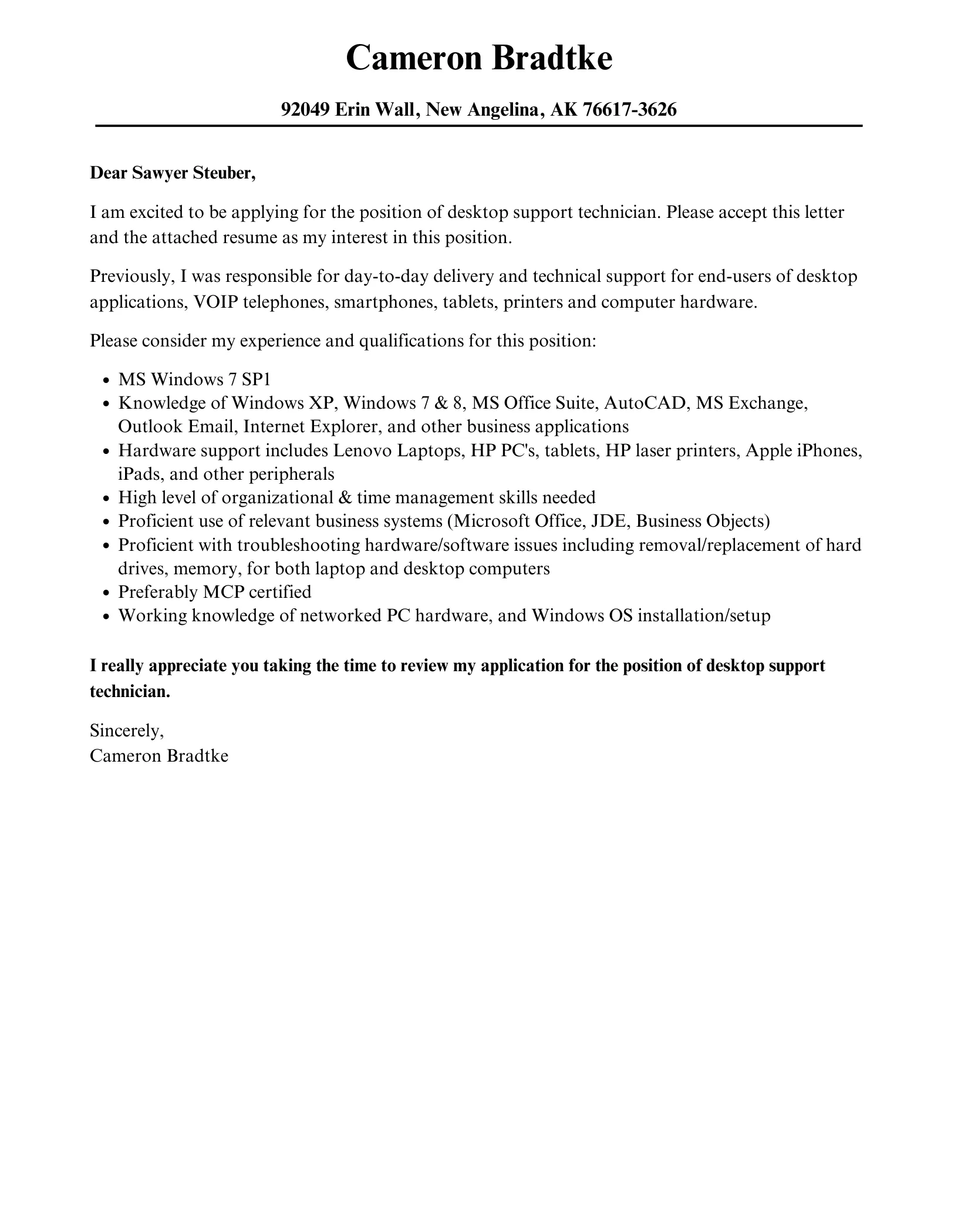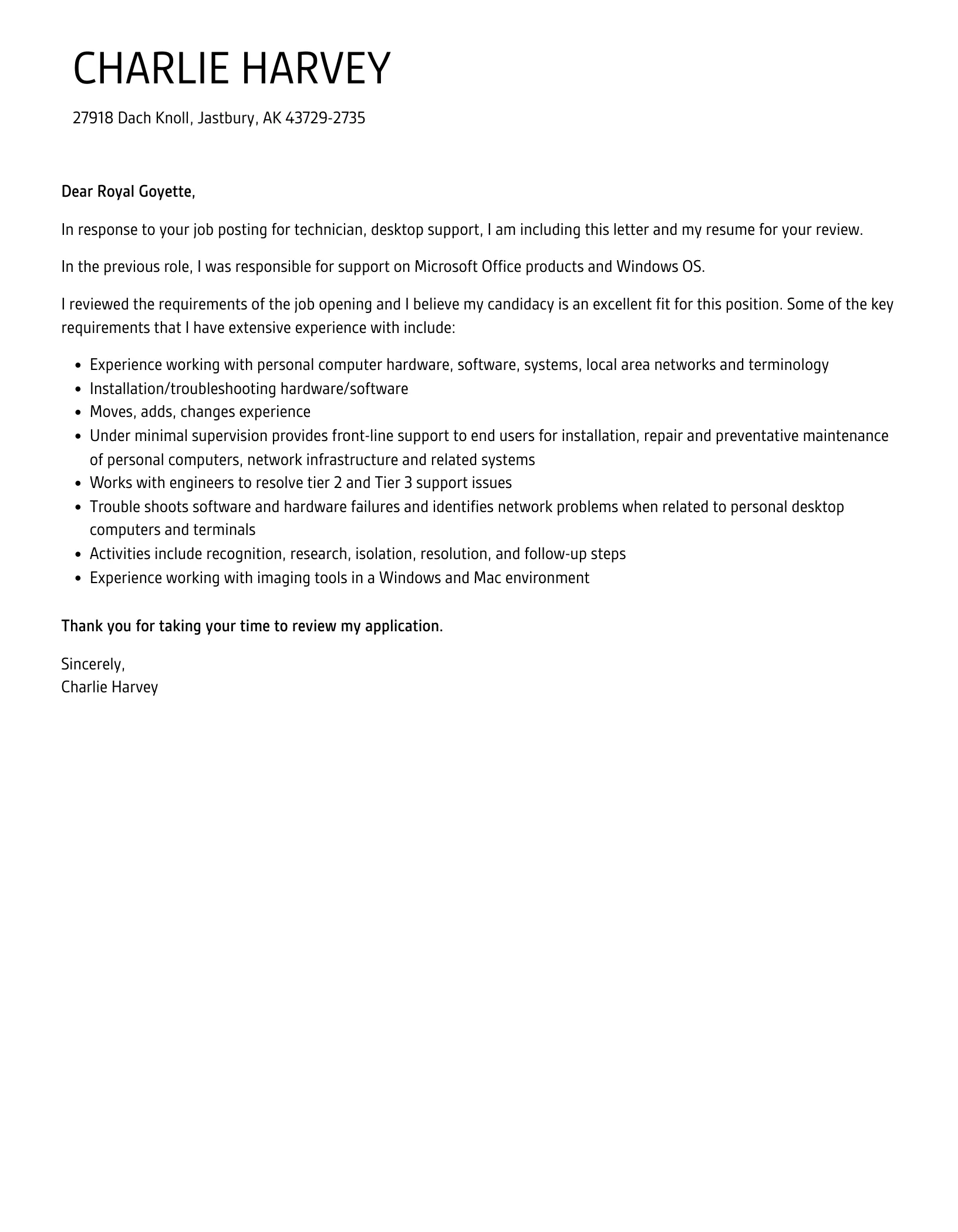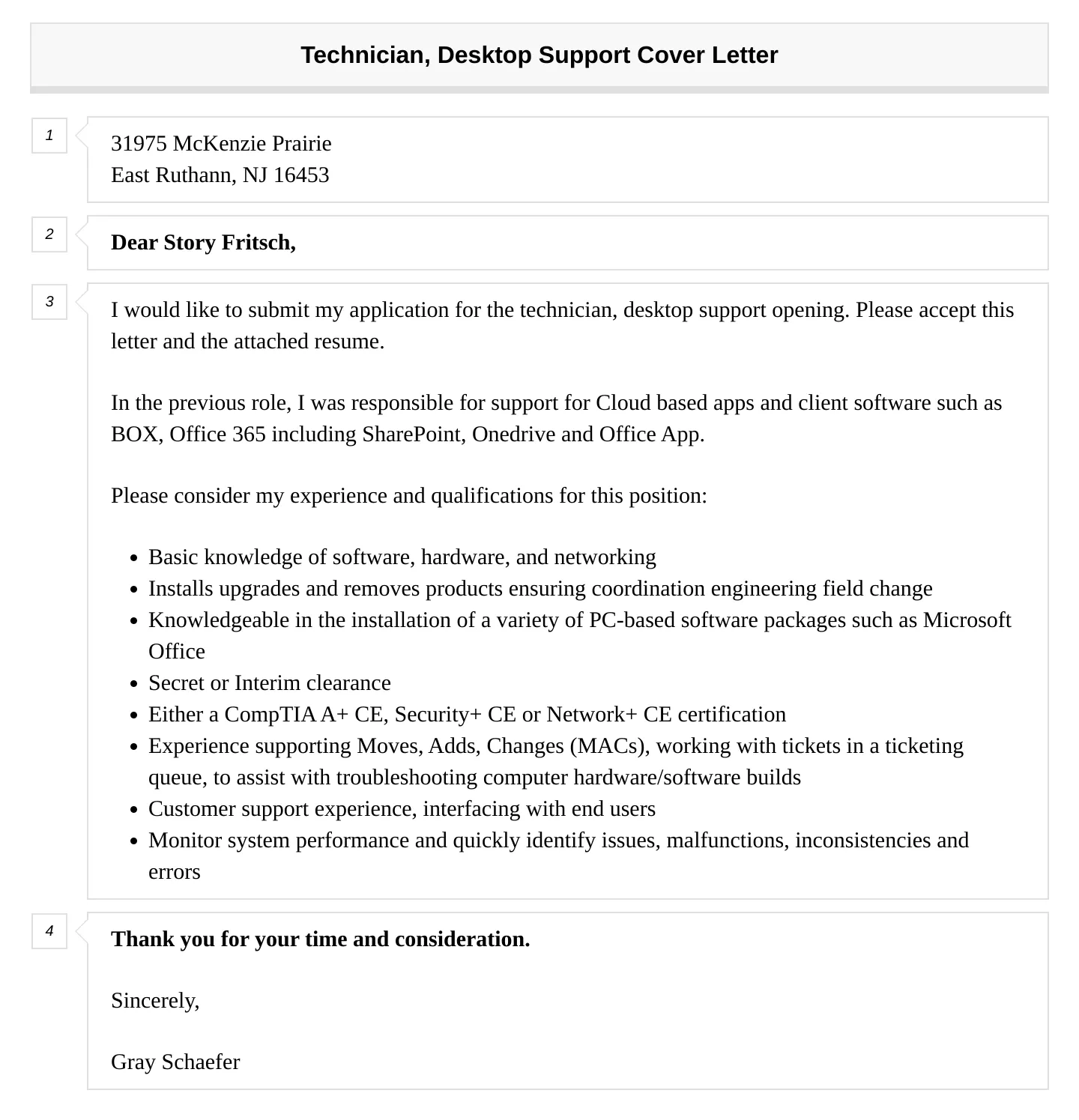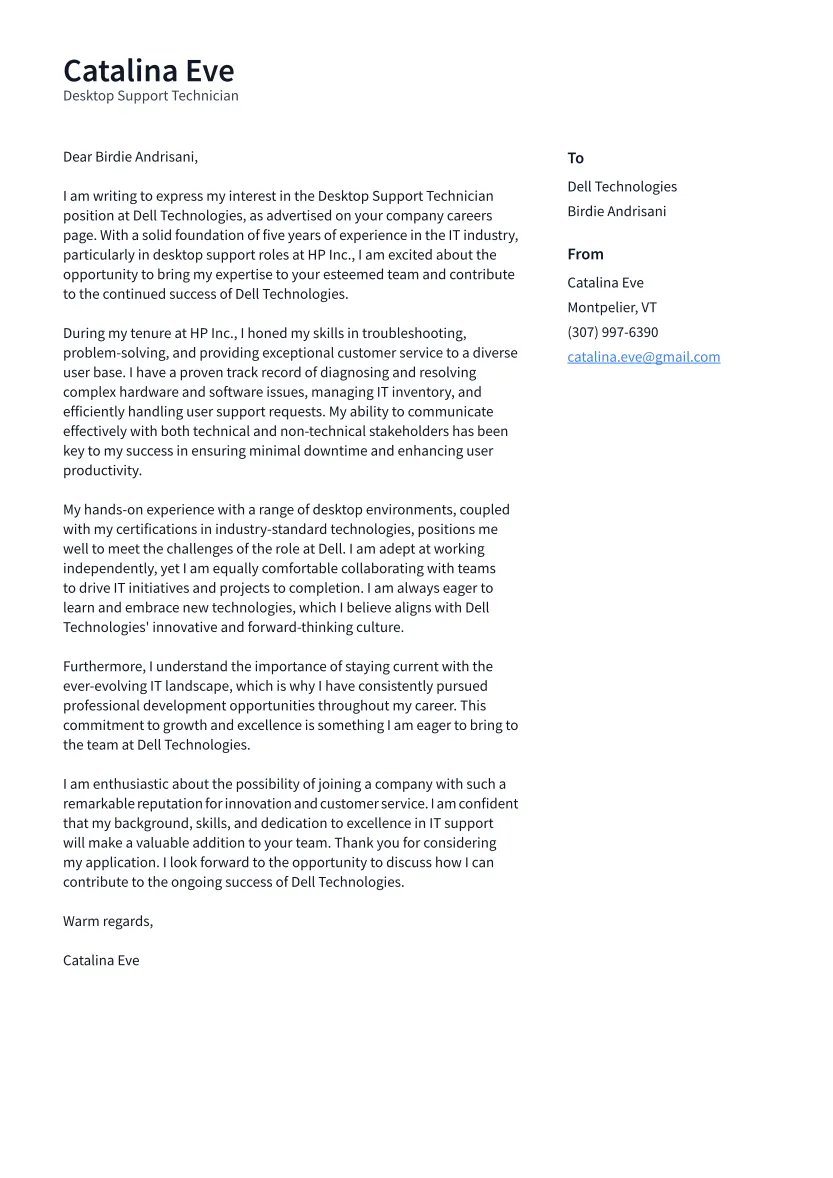Crafting Your Desktop Support Technician Cover Letter
A well-crafted desktop support technician cover letter is your first chance to make a positive impression on a potential employer. It’s more than just a formality; it’s a crucial tool in your job application arsenal. This guide will walk you through every step of creating a compelling cover letter that highlights your skills, experience, and enthusiasm for the role. By following these guidelines, you’ll significantly increase your chances of landing an interview and ultimately securing your dream job in the IT field. Remember, the goal is to showcase not only your technical abilities but also your personality and suitability for the company culture. A strong cover letter demonstrates your attention to detail, communication skills, and genuine interest in the opportunity.
Understanding the Importance of a Cover Letter
In the competitive job market, a cover letter serves as your personal introduction. It allows you to go beyond the bullet points of your resume and tell your story in a way that resonates with the hiring manager. A well-written cover letter demonstrates your understanding of the company and the specific requirements of the role. It provides context for your skills and experiences, explaining how they align with the company’s needs. Furthermore, a cover letter shows that you’ve taken the time to personalize your application, making you stand out from candidates who might be sending generic applications. It also showcases your writing and communication skills, which are essential in a desktop support role where you’ll be interacting with end-users and colleagues on a daily basis.
Key Components of a Desktop Support Cover Letter

A strong desktop support technician cover letter consists of several key components, each playing a vital role in conveying your qualifications. These components work together to create a cohesive narrative that highlights your suitability for the position. Let’s break down the essential elements to ensure your cover letter is impactful and professional. From the initial greeting to the closing, every section should be carefully considered and tailored to the specific job you’re applying for. The structure of your cover letter also matters; it should be easy to read and follow, with a clear flow of information that captures the reader’s attention.
Your Contact Information and the Date
Start with your contact information at the top of the cover letter. This should include your full name, address, phone number, and professional email address. Make sure this information is accurate and up-to-date. Directly below your contact information, include the date you are writing the letter. This provides a reference point for the hiring manager and ensures your application is current. The format should be professional, such as Month, Day, Year (e.g., May 15, 2024). Ensure the date is aligned with the rest of the header for a clean and organized appearance.
The Hiring Manager’s Contact Information
If possible, address your cover letter to a specific person. Research the hiring manager’s name and title (e.g., Mr. John Smith, Hiring Manager). Addressing the letter to a specific individual shows that you’ve taken the time to personalize your application, which can leave a positive impression. If you cannot find the hiring manager’s name, you can use a general salutation such as ‘Dear Hiring Manager’ or ‘Dear [Company Name] Hiring Team’. Ensure you spell the name and title correctly. This small detail demonstrates professionalism and attention to detail.
A Compelling Opening Paragraph

The opening paragraph is your opportunity to grab the reader’s attention. Start by stating the position you are applying for and where you saw the job posting. Briefly mention why you are interested in the role and the company. Consider including a captivating statement that highlights a key skill or achievement relevant to the position. This could be a brief summary of your experience or a statement reflecting your enthusiasm. Keep it concise and focused. Make the opening hook the hiring manager, motivating them to read the rest of your letter.
Highlighting Your Skills and Experience
The body of your cover letter is where you showcase your skills and experience. This is the main part where you link your qualifications to the job requirements. Focus on the skills and experience that are most relevant to the desktop support technician role. Use specific examples to illustrate your abilities, such as how you resolved a specific technical issue or improved a process. Quantify your achievements whenever possible (e.g., ‘Reduced help desk tickets by 15%’). Tailor your content to match the job description. The goal is to show the hiring manager how your experience directly translates to success in the role.
Technical Skills to Showcase
Desktop support technicians require a wide range of technical skills. Highlight your proficiency in areas such as operating systems (Windows, macOS), hardware troubleshooting (desktops, laptops, printers), networking basics (TCP/IP, DNS), and software installation and configuration. Make sure you list the specific software and hardware you have experience with. For example, mention any experience with Active Directory, remote desktop tools, or specific ticketing systems. Include any certifications (e.g., CompTIA A+, Microsoft Certified Professional) that you possess. Be specific about the tools and technologies you have used and how you used them to solve problems.
Troubleshooting Expertise

Troubleshooting is a core aspect of a desktop support technician’s role. Provide examples of how you approach and solve technical issues. Describe your troubleshooting process, highlighting your ability to diagnose problems, implement solutions, and document results. Mention any tools or techniques you use for troubleshooting, such as system logs, diagnostic software, or remote access tools. Highlight your ability to think critically, analyze problems, and find effective solutions. Show your ability to explain complex technical issues in plain language. Show you can collaborate with users and understand their needs.
Customer Service and Communication Prowess
Desktop support technicians often work directly with end-users, making excellent customer service and communication skills essential. Emphasize your ability to communicate technical information clearly and concisely, both verbally and in writing. Provide examples of your experience in helping users with technical issues, showing your patience, empathy, and problem-solving skills. Highlight your ability to actively listen, understand user needs, and provide effective solutions. Mention any experience with training or providing technical support to non-technical users. Your ability to build rapport and create a positive user experience is very important.
Quantifiable Achievements and Results
Whenever possible, quantify your achievements and results. Instead of saying, ‘Improved user satisfaction,’ state ‘Increased user satisfaction scores by 20% through improved response times.’ Use numbers and data to illustrate your impact. For example, mention how you reduced downtime, resolved issues faster, or streamlined support processes. Quantifiable results provide concrete evidence of your skills and abilities. Focus on the benefits you brought to previous employers. This makes your cover letter more compelling and provides hiring managers with tangible evidence of your value.
Demonstrating Your Value Proposition

Clearly articulate your value proposition to the hiring manager. Explain what you bring to the table and why you are the best candidate for the role. Highlight your key strengths and how they align with the company’s needs and goals. Tailor your value proposition to the specific job and company. Use the job description to identify the key requirements and demonstrate how you meet them. Show the hiring manager why they should hire you. Frame your skills and experience as solutions to their potential challenges. Provide a clear and concise summary of your expertise.
Tailoring Your Letter to the Job Description
Each cover letter should be customized for the specific job you are applying for. Carefully review the job description and identify the key skills, experience, and qualifications the employer is seeking. Align your cover letter with these requirements, highlighting the relevant skills and experiences that match. Avoid sending a generic cover letter; instead, personalize it to show the hiring manager that you have taken the time to understand their needs. Use the same keywords and terminology that are used in the job description. This helps demonstrate that you are a good fit for the position.
Using Keywords Effectively
Use relevant keywords throughout your cover letter. Keywords are the words and phrases that employers use to describe the job requirements and the skills they are looking for. Incorporate keywords from the job description naturally into your cover letter. Make sure you don’t stuff keywords; instead, use them contextually. By using relevant keywords, you increase the chances of your cover letter being noticed by applicant tracking systems (ATS). They also make your application more relevant to the hiring manager. Review the job description multiple times and use keywords strategically.
Formatting and Presentation Best Practices

The formatting and presentation of your cover letter are crucial. Use a professional and easy-to-read font, such as Times New Roman, Arial, or Calibri, and a font size between 10 and 12 points. Use consistent formatting throughout the letter, including headings, spacing, and bullet points. Keep the letter concise and easy to read, aiming for a maximum of one page. Use clear and concise language, and avoid jargon. Proofread your cover letter carefully to eliminate any typos or grammatical errors. Ensure the format is consistent with the formatting of your resume.
Writing a Strong Closing Paragraph
Your closing paragraph should reiterate your interest in the position and express your enthusiasm for the opportunity. Reiterate your key qualifications and how they align with the job requirements. Clearly state your desire for an interview and include a call to action. Thank the hiring manager for their time and consideration. Provide your contact information again, and indicate your availability for an interview. Keep the closing paragraph positive and professional, leaving the hiring manager with a positive impression. End your letter with a professional closing like ‘Sincerely’ or ‘Best regards’.
Expressing Enthusiasm and Availability
Show your enthusiasm for the role and the company. Mention something specific that excites you about the opportunity. Be clear about your availability for an interview. If you are available immediately or have specific dates in mind, state them. Make it easy for the hiring manager to contact you. Express your willingness to discuss your qualifications in more detail. Emphasize your eagerness to contribute to the company’s success.
Proofreading and Editing Your Cover Letter

Proofreading and editing are essential steps in the cover letter writing process. Carefully review your cover letter for any typos, grammatical errors, and formatting inconsistencies. Read your letter aloud to catch any awkward phrasing or unclear sentences. Ask a friend or colleague to review your cover letter for feedback. Make sure that your letter aligns with your resume. Ensure the language is professional, clear, and concise. Take your time and do not rush through this step. A well-proofread cover letter demonstrates your attention to detail and professionalism.
Common Mistakes to Avoid
Certain mistakes can significantly diminish the effectiveness of your cover letter. Avoiding these common pitfalls can make your application much more competitive. Here are some key areas to pay attention to.
Overly Generic Language
Avoid using generic phrases that could apply to any job or company. Instead, tailor your language to the specific role and company. Use specific examples from your experience, rather than broad generalizations. Focus on your unique skills and accomplishments. Generic cover letters show a lack of effort and interest. Demonstrate how you have researched the company and the role.
Typos and Grammatical Errors

Typos and grammatical errors can undermine your credibility. Always proofread your cover letter carefully, and consider using grammar-checking software. Double-check the spelling of the hiring manager’s name and the company’s name. Errors can create a negative impression and suggest a lack of attention to detail. Ask someone else to review your cover letter for you. Make sure you are using the correct verb tenses.
Ignoring the Job Description
Failing to address the specific requirements of the job description is a significant mistake. Carefully read the job description and tailor your cover letter to demonstrate how your skills and experience align with the employer’s needs. Use keywords and phrases from the job description to show you have carefully considered the requirements. Show the hiring manager that you understand the role. Failure to customize your cover letter may result in rejection.
Sending Your Cover Letter
After you have finalized your cover letter, you need to consider how you will submit it. The submission process plays a key role in presenting your application.
File Format and Delivery
Unless specified otherwise in the job posting, submit your cover letter in PDF format. PDF files preserve the formatting of your cover letter. When submitting via email, include your cover letter and resume as attachments. Use a clear and professional email subject line, such as ‘Desktop Support Technician Application - [Your Name]’. Ensure your email includes a brief introductory message. Always follow the instructions in the job posting. Use clear and professional file names for your attachments.
Follow-up Strategies
After submitting your cover letter and resume, it is essential to follow up. Following up demonstrates your interest in the role and your persistence. It is also a good chance to emphasize your interest again.
Preparing for the Interview
If you receive an interview invitation, prepare thoroughly. Research the company and the role. Review your cover letter and resume, and anticipate questions. Prepare examples of your experience, using the STAR method (Situation, Task, Action, Result). Practice answering common interview questions and ask thoughtful questions. The more prepared you are, the more confident you will feel during the interview. Make sure to dress professionally and arrive on time.
Conclusion
Creating a compelling desktop support technician cover letter is essential for landing your dream job. By following the guidelines provided in this guide, you can craft a cover letter that highlights your skills, experience, and enthusiasm, making a strong first impression on potential employers. Remember to tailor your cover letter to each specific job, using relevant keywords and quantifying your achievements. Proofread carefully, and always present your application professionally. Good luck with your job search!
